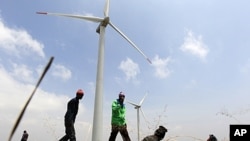It all began almost two decades ago, when Willem Dolleman got annoyed during his Lake Turkana vacation in Kenya's Great Rift Valley. He wanted to fish and set up his tent, but the ever-blowing gales kept undermining his efforts. Despite his frustration, Dolleman thought it could be interesting to harness all of this natural power.
Fast forward to mid-2000, when oil prices were shooting through the roof. Dolleman discussed his idea with colleagues who eventually formed the Lake Turkana Wind Power project.
With construction slated to begin in March, it will be sub-Saharan Africa's largest wind-power project, expected to contribute up to one-fifth of Kenya's power-generating capacity, one of the biggest contributions by wind power to a national grid anywhere in the world.
Best wind on the continent
Lake Turkana Wind Power chairman Carlo Van Wageningen says that the wind, when measured on the original site, had an average speed of 13 meters per second, dwarfing the average European wind farm speeds of about 7.5 meters per second.
"The problem is that there is no wind turbine producer in the world that produces a wind turbine that can sustain such high averages," says Van Wageningen. "So we had to move a little bit from that site to try and identify a site where we had less wind, because we had too much of it."
The new location offers more manageable wind speeds of around 11.5 meters per second, which, upon project completion, will be captured by 365 turbines. Slated to begin construction around March 2012, the fully operational farm will be expected to provide 300 megawatts to Kenya’s national grid, about 20 percent of the country’s installed power-generating capacity.
Wageningen calls the site one of the best on the continent. Winds from the Indian Ocean are attracted to the low-pressure Sahara Desert. That low-level jet stream blows through what is known as the Turkana Corridor, created by a valley between two mountain ranges.
"It is very predictable wind," he says. "If you look at our graphs on the wind patterns we have, you’ll find that at 10 o’clock in the morning or at 6 o’clock in the evening of every day, the wind is pretty much the same for every day."
Entire region coming online
Sub-Saharan Africa is just beginning to come on board with wind power, although its contributions to the world supply remain negligible. According to the World Wind Energy Association, Africa accounted for only 0.4 percent of new wind installations in 2010.
The association says Africa’s total installed capacity in 2010 was 906 megawatts out of a world total of more than 193,000 megawatts.
That number is set to rise, however, with the project in Kenya and another one in Ethiopia. The Ethiopian government recently launched six wind power projects and one geothermal power plant in a bid to become Africa's top green power exporter. Ethiopian officials say the seven projects are expected to be capable of generating 1,015 megawatts of electricity.
Great expectations
According to Hermann Oelsner, president of the African Wind Energy Association, a Johannesburg non-governmental organization, there are also high hopes that South Africa will develop its own wind resources.
"South Africa has the shorelines in the west, in the east, and in the south, and there are four harbors," he says, explaining that the country has plenty of wind, sun and wave activity to justify substantial green-energy investment. "Factories where components can be manufactured locally are already in existence."
But Oelsner is quick to note that Africa's numerous infrastructure concerns, from poor roads to off-the-grid development sites, are a red flag to prospective investors.
Although energy demand is growing across the continent, with average annual economic growth rates of five to eight percent, Oelsner thinks Africa can be more creative in finding and using alternative energy sources.
"Africa could actually be leading the rest of the world in applying renewable energy in a smaller way; rural areas, etcetera, and using biofuels as well," he says.
He says it is crucial that this happen, as humans are using up the world's natural resources.
Africa's Future, Blowing in the Wind











